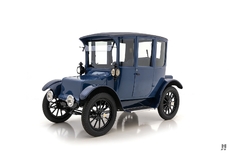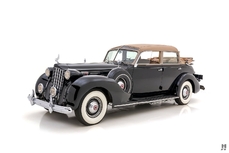Apollo 5000 GT 1964
General description :
In the early 1960s, an aspiring young American engineer named Milt Brown dreamed of designing and building an American sports car to compete with the likes of Aston Martin, Maserati or Ferrari. There has never been a shortage of enthusiasts sharing the same dream; however, Milt Brown was among a select few to turn his into reality. Putting his engineering skills to good use, he designed a tubular, coil-sprung chassis from scratch, while his friend Ron Plescia, himself a graduate of Pasadena’s elite Art Center College of Design, did the initial styling work for the body. For the engine, Milt instead turned to Buick, for their new all-aluminum 215 cubic-inch V8, which was compact, lightweight, and powerful. He hoped to sell the car through select Buick dealers, but the deal never worked out, perhaps because GM wanted to protect the Corvette.
With the design settled, he partnered with Frank Reisner of Carrozzeria Intermeccanica in Turin, Italy. Intermeccanica had a solid reputation for high-quality tuning parts and racing cars. At Reisner’s suggestion, the famous Italian designer Franco Scaglione refined the design, lending the project serious credibility. Scaglione added rear quarter windows, reworked the tail to taper subtly, and shortened the nose to create a beautiful and balanced fastback coupe. Intermeccanica handled the construction of the chassis and body, then shipped the trimmed and painted cars to Oakland, California, to install the running gear.
On its debut, Road & Track lavished praise on the new Apollo GT for its balanced handling, surprising comfort, and exciting performance. Despite the very favorable press, the project faltered due to the costly assembly process and lack of a suitable dealer network. The more powerful, 4.9-liter Buick Skylark-powered 5000 GT was a welcome addition, but problems were too much to overcome, and Brown soon lost control of the project. The remaining cars were assembled in Texas and sold as the Vetta Ventura, but in the end, approximately 88 examples of the 3500 GT, 5000 GT, Apollo Spyder, and Vetta Ventura were produced in total.
Offered here is chassis number 1074, the second-to-last coupe produced, and one of a handful to feature the desirable 4.9-liter Buick Skylark V8. This fabulous example is one of only two cars finished by Intermeccanica in British Racing Green and it has covered just under 4,000 miles from new. It boasts a well-documented ownership history, including a period when it belonged to Apollo creator Milt Brown. In a 2004 letter, Milt Brown attested to the car’s exceptional originality and mileage. According to Brown, 1074 was the best-preserved Apollo in the world, having spent 35 years carefully stored in a dry environment in Southern California, and during the time of his ownership, it showed fewer than 1,300 miles, which is noted on a copy of the California title in his name.
The Apollo later traded hands to a collector who commissioned a high-quality respray in the original shade of British Racing Green. Great care was taken to preserve the correct Borrani wire wheels, exterior chrome trim, and the delicate aluminum alloy “eggcrate” grille. The paintwork is finished to a high standard, displaying smooth, even finishing, and very straight coachwork. This dark green shade suits the Apollo’s proportions exceptionally and highlights the lovely design and beautifully crafted coachwork.
Apollo GTs are renowned for their comfort and accommodating driving position. Even taller drivers would feel great after a day’s touring behind the wheel, thanks to the generous headroom, plenty of legroom, and supportive seats. The black leather seat upholstery has been restored, while the doors panels, dash covering, carpets, and interior fittings are all original. It includes the rare factory-fitted 3-spoke steering wheel, an original array of Jaeger dials, and correct switches all in superb order. The intricately engraved ashtray is similar to those seen on many coachbuilt Italian cars of the period, and it remains crisp and like-new, down to the tiny Apollo emblem. The boot houses the original spare wheel and Pirelli Cinturato tire.
Buick’s powerful 300 cubic-inch V8 (shared with the Skylark) sits under the bonnet, dressed with a chrome air cleaner and Apollo-badged finned alloy valve covers. The engine bay and undercarriage are honest and tidy, reflective of the car’s preserved nature, while also showing signs of maintenance and care to ensure it remains in top running order. The balanced chassis, robust American V8, and remarkably comfortable interior make the Apollo one of the best-kept secrets for historic road rallies and touring events.
While in the care of previous owners, chassis 1074 appeared at the 2010 Milwaukee Concours, and earned an AACA National First Prize at the 2012 Cedar Rapid, IA meet. It remains in superb condition, suitable for preservation class concours events or driving enjoyment. With provenance that includes ownership by its creator, Milt Brown, this genuinely remarkable Apollo 5000 GT will be a welcome addition to the most exclusive collections.
Offers welcome and trades considered
https://hymanltd.com/vehicles/6726
1964 Apollo 5000 GT is listed sold on ClassicDigest in St. Louis by Mark Hyman for $225000.
Car Facts
Car type : Car Make : Apollo Model : 5000 GT Engine size : 0.0 Model Year : 1964 Location : Missouri
Sold
Seller Information
Sold
Other cars listed for sale by this dealer
About Apollo
The Apollo is an interesting Italo-American GT car that was produced in the 1960s. It was designed to offer a combination of American power and Italian styling. Regarding its status as a "great" or a "poor man's Ferrari," opinions may vary among automotive enthusiasts. Here are some points to consider:1. Design and Styling: The Apollo had sleek and attractive styling influenced by Italian design. It featured a low-slung profile, elegant lines, and often sported muscular American V8 engines. The design aimed to capture the essence of high-performance European sports cars.
2. Performance: The Apollo's performance was notable, thanks to its powerful engines. It was typically equipped with American V8 engines sourced from companies like Buick and Oldsmobile, which offered significant horsepower and torque. This allowed the Apollo to deliver strong acceleration and impressive top speeds.
3. Build Quality and Development: The Apollo was produced in limited numbers, and there were some challenges with build quality and development. The company faced financial difficulties and lacked the resources of established manufacturers like Ferrari. As a result, some owners experienced reliability issues and the overall refinement of the car could be seen as underdeveloped compared to its competitors.
4. Potential with Better Resources: It is plausible to assume that with better resources, the Apollo could have achieved even greater success. More investment in development, engineering, and production could have addressed the reliability and build quality issues, potentially leading to a more refined and competitive sports car.
Ultimately, whether the Apollo is considered a "great" or a "poor man's Ferrari" is subjective. It had its own unique charm and performance characteristics. While it may not have achieved the same level of recognition or prestige as Ferrari, it still holds a place in automotive history as an interesting and distinctive GT car that combined Italian styling with American power.
The Apollo was produced in a few different models during its production run. Here are some key models, specifications, and estimated production numbers for the Apollo GT:
1. Apollo 3500 GT:
- Engine: 3.5-liter V8 engine sourced from Buick
- Power: Approximately 200 horsepower
- Transmission: 4-speed manual or optional automatic
- Production Numbers: Around 88 Apollo 3500 GTs were produced between 1962 and 1964.
2. Apollo 5000 GT:
- Engine: 5.0-liter V8 engine sourced from Buick
- Power: Approximately 300 horsepower
- Transmission: 3-speed automatic or optional 4-speed manual
- Production Numbers: Approximately 90 Apollo 5000 GTs were produced between 1964 and 1965.
3. Apollo 3500 GT Spider:
- Engine: 3.5-liter V8 engine sourced from Buick
- Power: Approximately 200 horsepower
- Transmission: 4-speed manual or optional automatic
- Production Numbers: Around 11 Apollo 3500 GT Spiders were produced between 1963 and 1964.
4. Apollo 5000 GT Spider:
- Engine: 5.0-liter V8 engine sourced from Buick
- Power: Approximately 300 horsepower
- Transmission: 3-speed automatic or optional 4-speed manual
- Production Numbers: Only a few Apollo 5000 GT Spiders were produced, making the exact number uncertain, but it is estimated to be in the single digits.
Overall, the total production numbers of the Apollo GT are relatively low, with approximately 200-250 cars produced in total across all models. The exact production figures may vary, and it's worth noting that the Apollo went through different ownership and production changes during its production run, which may have influenced the overall numbers. These limited production numbers contribute to the rarity and collectibility of the Apollo GT today.




















